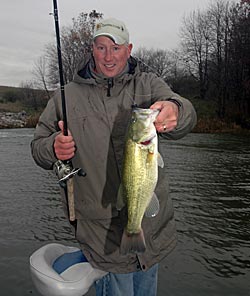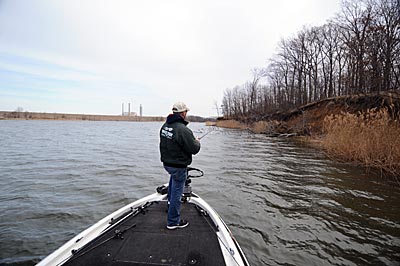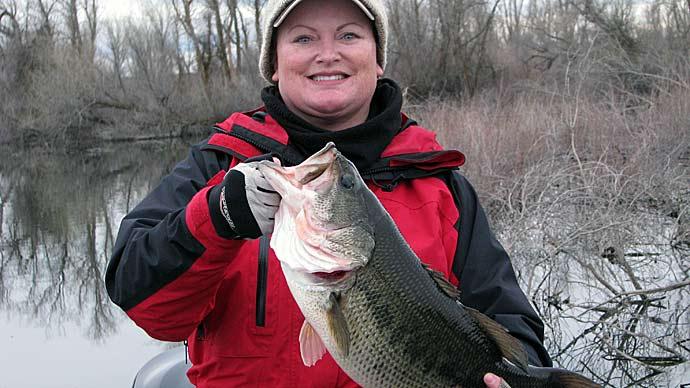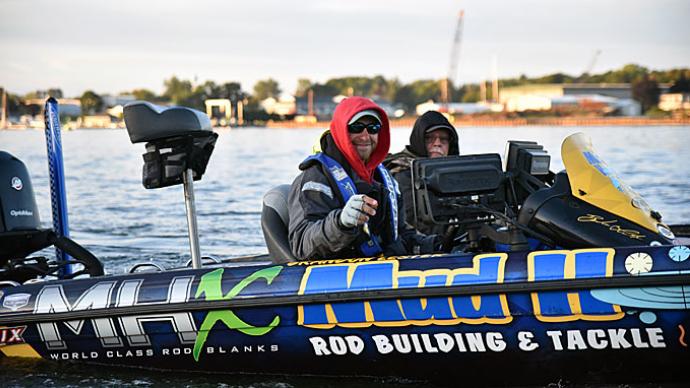
When the winter weather gets bitter cold, bass fishing action gets hotter on power plant lakes.
Power plant reservoirs such as Newton Lake in Illinois provide year-round warm water bass fishing because these lakes double as cooling reservoirs for the power plants. The power company pumps water into the plant to cool down its power production equipment, which heats the water. The heated water is then discharged back into the lake through a canal. The water around this discharge area is usually 10 to 20 degrees warmer than other lakes in the area.
Then the general rule for power plant lakes is that fishing gets better when the winter weather turns colder because the plant has to produce more electricity to meet demands. The increase in production makes it necessary to pump in more water to cool down the equipment, and more hot water is discharged back into the lake, which heats the lake and the bass fishing.
“The most important thing about (fishing power plant lakes) is water temperature,” said Tab Walker, owner of Outdoor Sportsmen’s Lodge at Newton Lake. “What is funny about power plant lakes is that you can try patterns there in the wintertime that you wouldn’t be fishing on a regular lake until May or June,” Walker says. “There are times when it would be January, and I would be in 70-degree water throwing topwater baits like walk-the-dog baits and poppers—things that you wouldn’t be thinking about throwing in 15- or 20-degree weather.”
Walker’s favorite wintertime tactic for catching power plant lake bass is throwing topwater lures such as the Strike King Sexy Dawg, topwater poppers, or buzz baits in the hot water discharge area where the water temperature is at least 60 degrees. “All those topwaters they will hit in that warmer water,” Walker says. “What is crazy is the worse the weather is, the more they like it. I have been out there on days when nobody in their right mind would be fishing the lake, but the fish were biting like crazy.”
When cold fronts shut down bass on surrounding lakes in the wintertime, power plant bass keep on munching. “Those fish don’t care about cold fronts when they are in 70-degree water,” Walker says. Catching bass on topwater lures in a winter snowstorm is a common occurrence in the hot water section of Newton Lake.
When he fishes farther away from the hot water discharge, various lures work for Walker. He notes the water is still warm enough to throw jigs, square bill crankbaits, and lipless crankbaits. If the water is stained, Walker throws a thumping magnum spinnerbait or a Chatterbait. Walker suggests you can retrieve these lures at the same pace as you would in the spring because the water is still warm despite the cold weather.

When water discharges into the canal, current becomes a factor in positioning bass in the warmer water. Walker notices at Newton Lake, the best fishing in the hot water area is when the lake has experienced a dry autumn, and the lake level is 1 to 2 feet low, which causes the current to run faster. “That current will form some little sandbars that have only about a 6-inch drop, but those bass will push shad right up against that little edge, and that is where the bass will gang up on little places like that,” he says. “I catch them on those places a lot with topwater baits.”
Wintertime patterns exist on the cold side of a power plant lake, but bass on the discharge side remain in a springtime mode throughout the winter. “All winter long, the fish do the same thing and just chase shad up in that top end of the warm water side,” Walker says. “Then the fish there will go into the prespawn mode in late February or early March.
“What is different about a power plant lake like Newton as opposed to a regular lake is on most lakes, the spawning cycle might last only a month or happens simultaneously around the lake,” Walker says. “But in Newton, it will start on the hot water side in February, and then you can just follow it all the way around the lake. So the spawn at the top starts happening by March 1, and then by the end of March, they might be spawning in the middle part of the lake, and it might be May 1 before they are spawning up the cold water side.” Walker estimates the spawn throughout Newton could last for three months or more.
While the water in the discharge area of Newton and other power plant lakes is warm, the air temperatures can still be frigid. “I have been out there days before when it was zero degrees,” Walker says. The Illinois angler suggests dressing in insulated coveralls and thermal clothing to stay warm in the bitter cold.




